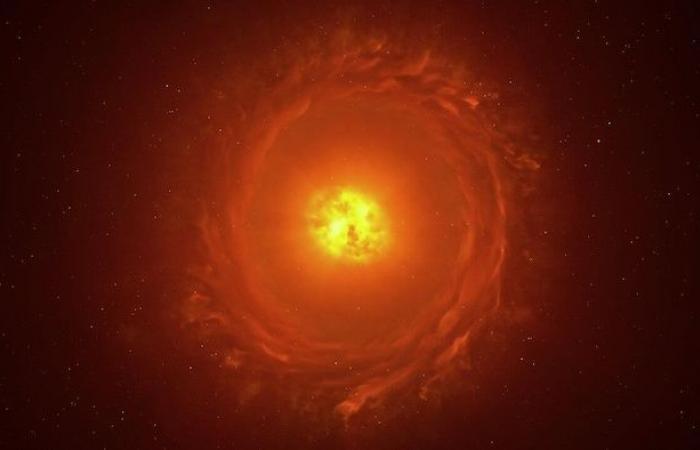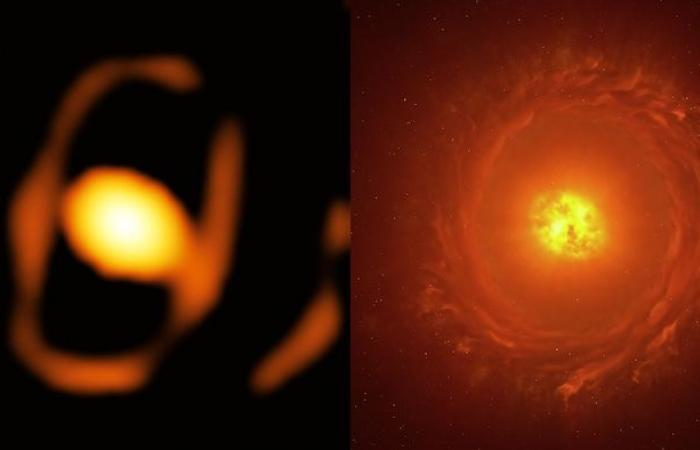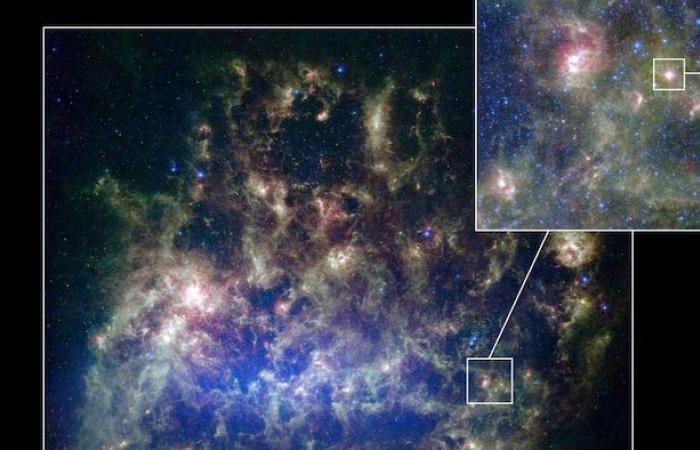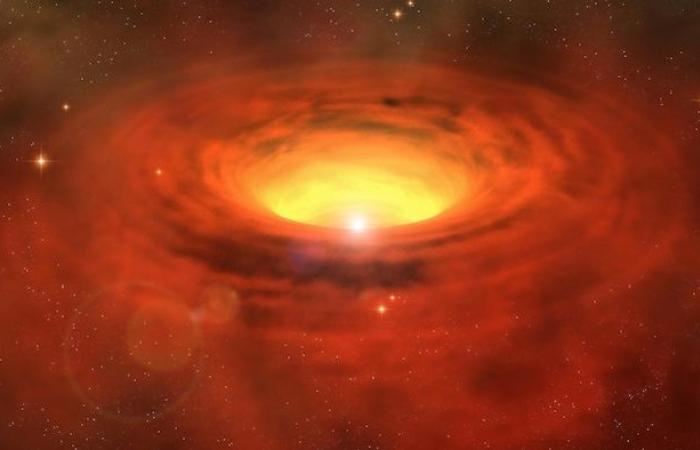The Very Large Telescope of the European Southern Observatory (ESO) located in Chile made it possible to visualize the star WOH G64 located in a neighboring galaxy, 160,000 light years from our solar system.
Open in full screen mode
Artistic reconstruction of the appearance of the star WOH G64, the first star outside our galaxy to be imaged in close-up.
Photo: ESO/L. Sidewalk
The image was obtained thanks to the high precision of the telescope’s interferometer, an instrument whose operating mode allows very high resolutions to be obtained.
The photo reveals a star exhaling gas and dust, in the final stages of its existence before it explodes and becomes a bright supernova.
Open in full screen mode
Located in the Large Magellanic Cloud, a staggering distance of more than 160,000 light years from us, WOH G64 is a dying star approximately 2,000 times the size of the Sun.
Photo: ESO/K. Ohnaka et al., L. Calçada
We directly observed an egg-shaped cocoon surrounding the star
notes in a press release the Japanese astrophysicist Keiichi Ohnaka, the main author of the work published in the journal Astronomy & Astrophysics (New window) (in English).
We are delighted with this observation since this cocoon would be linked to the energetic ejection of material from the star occurring just before it transforms into a supernova.
Close-up on WOH G64
To date, astronomers have captured more than two dozen close-up images of stars in our Milky Way, helping to better understand their properties. But detailed observation of a star located outside of it remained extremely difficult due to technical complexity.
The star WOH G64 is located in the Large Magellanic Cloud, the third closest galaxy to ours. With the Milky Way and Andromeda, this cloud is part of the Local Group which brings together 60 galaxies.
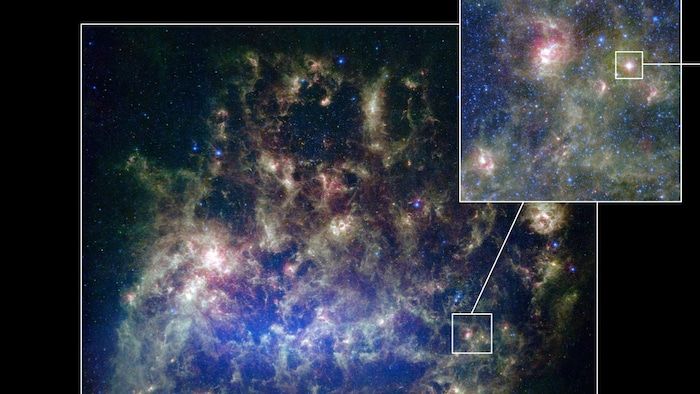
Open in full screen mode
The position of the supergiant star WOH G64 in the Large Magellanic Cloud
Photo: THAT
Nicknamed the juggernaut star
this red supergiant type star is approximately 2000 times larger than the Sun. For example, placed in the center of our solar system, it would be so big that it would engulf Mercury, Venus, Earth, Mars and even Jupiter.
Researcher Keiichi Ohnaka and his colleagues have been interested in WOH G64 since 2005. They had succeeded in characterizing certain elements, but had never obtained an image of the star.
To obtain this image, the international research team used the GRAVITY instrument of the telescope’s interferometer. After pairing the recent data with past observations of the star, scientists found that WOH G64 had dimmed in the last decade.
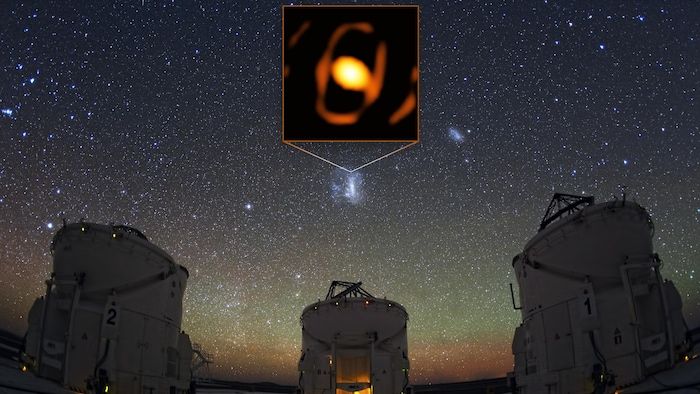
Open in full screen mode
The Large Magellanic Cloud is a galaxy neighboring the Milky Way.
Photo: ESO/K. Ohnaka et al./Y. Beletsky (LCO)
We found that the star has undergone a significant change over the past ten years, giving us a rare opportunity to observe the life of a star in real time
says German astronomer Gerd Weigelt, from the Max Planck Institute for Radio Astronomy in Bonn, co-author of the study.
Die in a blast
According to some estimates, WOH G64 could explode and become a supernova within the next 10,000 years.
During their final phase of life, red supergiants like WOH G64 shed their outer layers of gas and dust in a process that can last thousands of years
explains in the press release astronomer Jacco van Loon, of the Keele University Observatory in the United Kingdom.
This star is certainly one of the most extreme of its kind, and any drastic changes could bring it closer to an explosive end.
Also, the photo shows that the cocoon is stretched. The researchers expected to see a different shape based on previous observations and computer models.
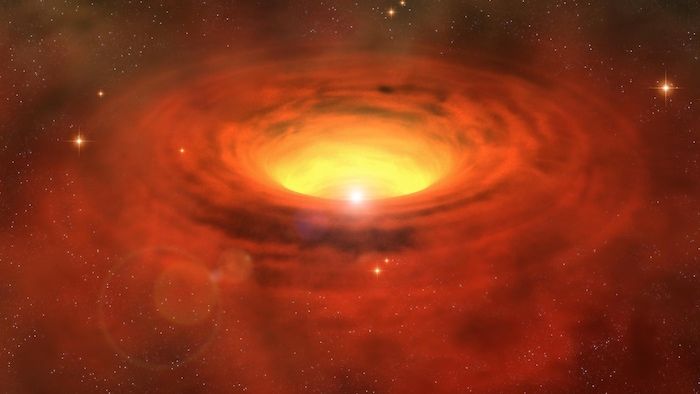
Open in full screen mode
Artistic illustration of the WOH G64 star
Photo: THAT
According to them, this ovoid shape of the cocoon could be explained by the erosion of the star or by the influence of an unknown companion star. Indeed, WOH G64 may form a binary system, but this possibility has not yet been confirmed, due to the opaque clouds of dust that surround it.
It is also possible that the composition (materials) of the layer could be behind the darkening and unexpected shape of the dust cocoon around the star
.
As the star gradually becomes less luminous, it will be more and more difficult to take close-up photos of it, even with the most efficient current instruments.
The Very Large Telescope will, however, be equipped by 2026 with the GRAVITY+ instrument, which could make it possible to observe the star further in order to better understand its evolution.
In addition, by 2027, theTHAT will be equipped with another observation tool, the Giant European Telescope, currently under construction in Chile, which will also allow us to zoom in on specific regions with an unprecedented level of detail, giving us an unprecedented close-up view of the stars.
Context
- It is difficult to estimate the number of stars that are found in each of the 2000 billion galaxies populating the Universe.
- Let’s take our Milky Way: it alone has 100 billion stars, according to the most recent estimates.
- Thus, with the Milky Way as a reference, we must multiply the number of stars in a galaxy (100 billion) by the number of galaxies in the Universe (2000 billion) to obtain an estimate of the number of stars in the cosmos.
- There would thus be 200 billion billion stars in the Universe, which corresponds to 200 sextillion.
- This is of course only an estimate of the order of magnitude of our world, since not all galaxies are identical. Now imagine the number of planets in the Universe!

